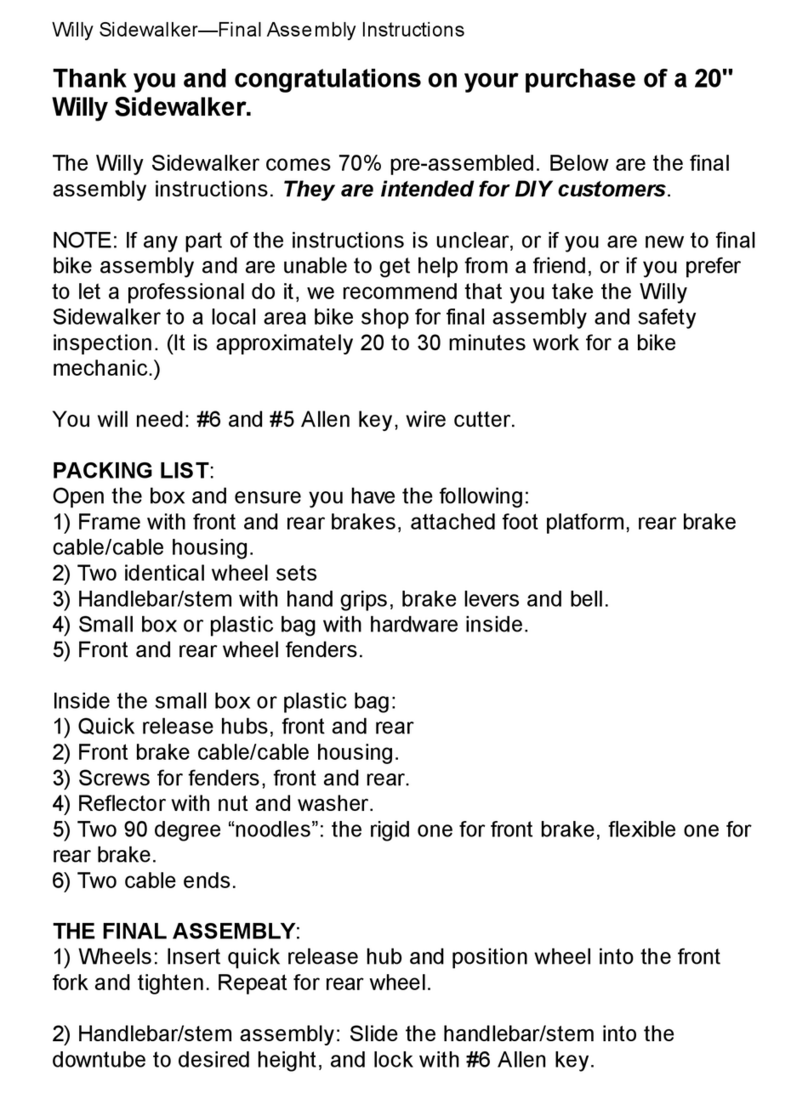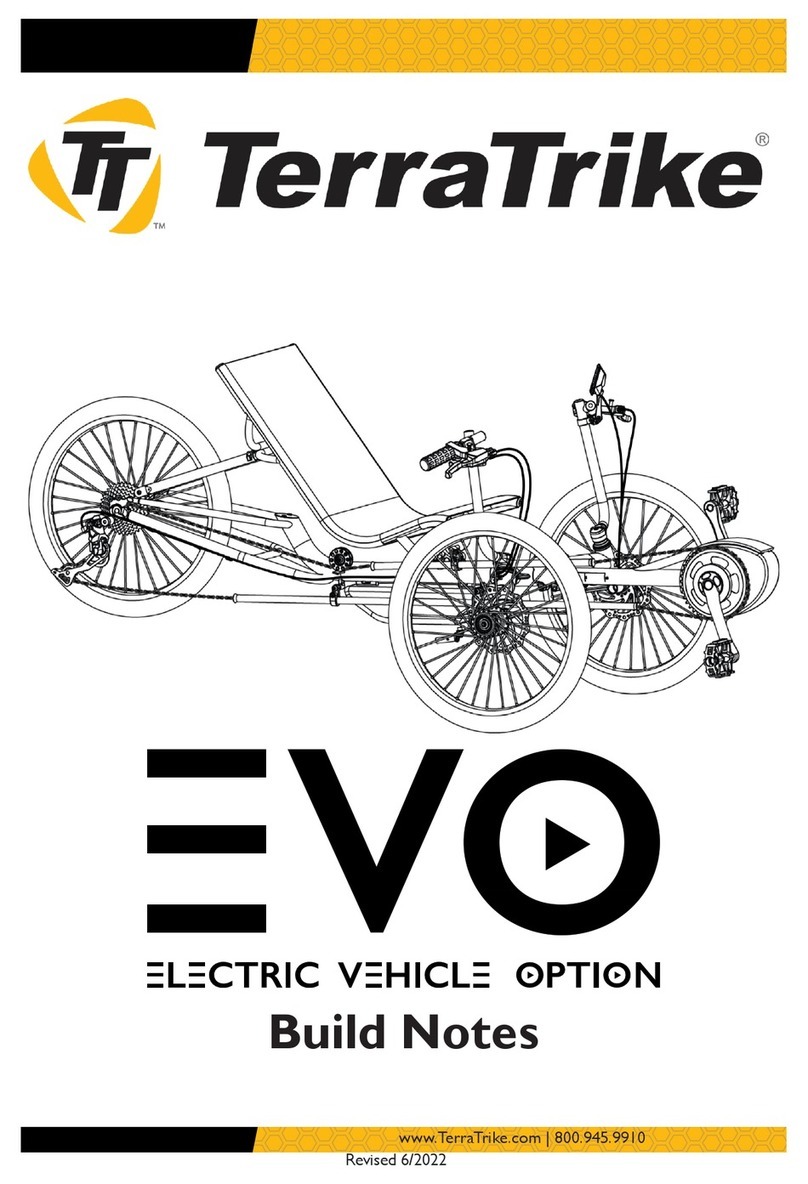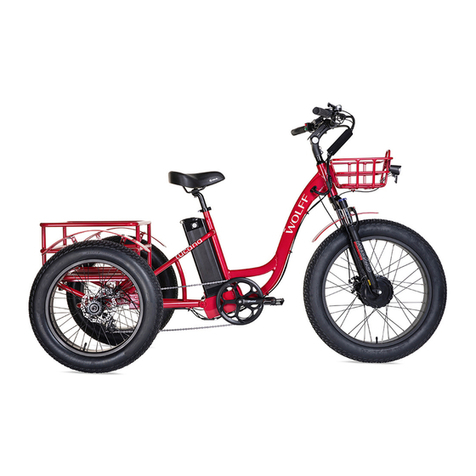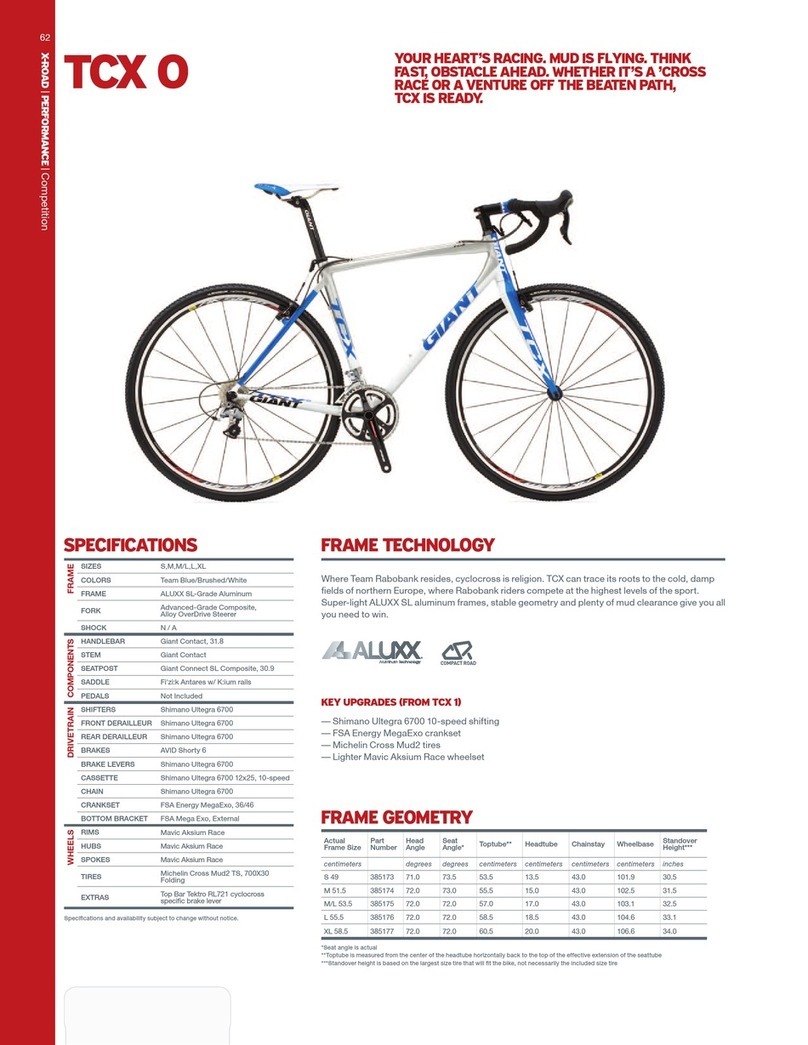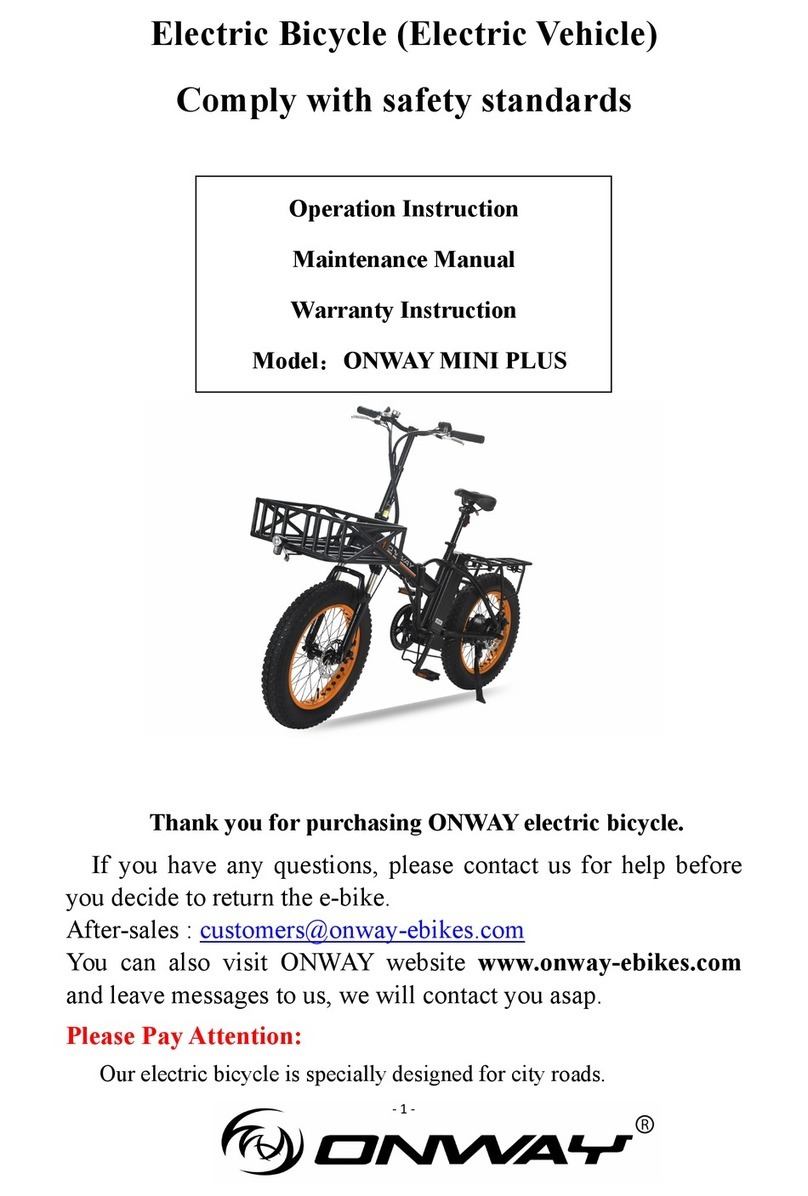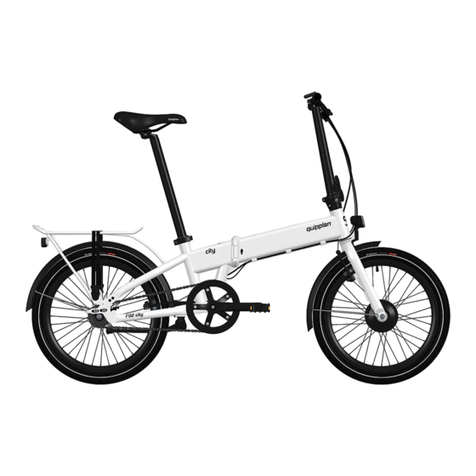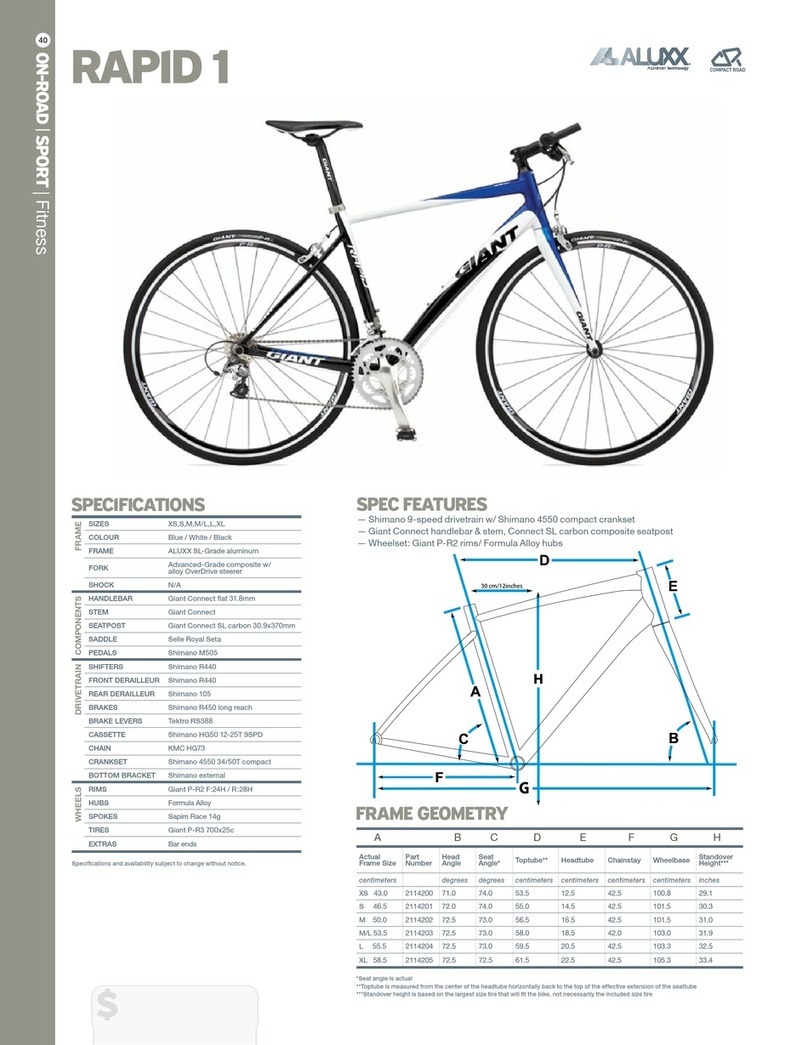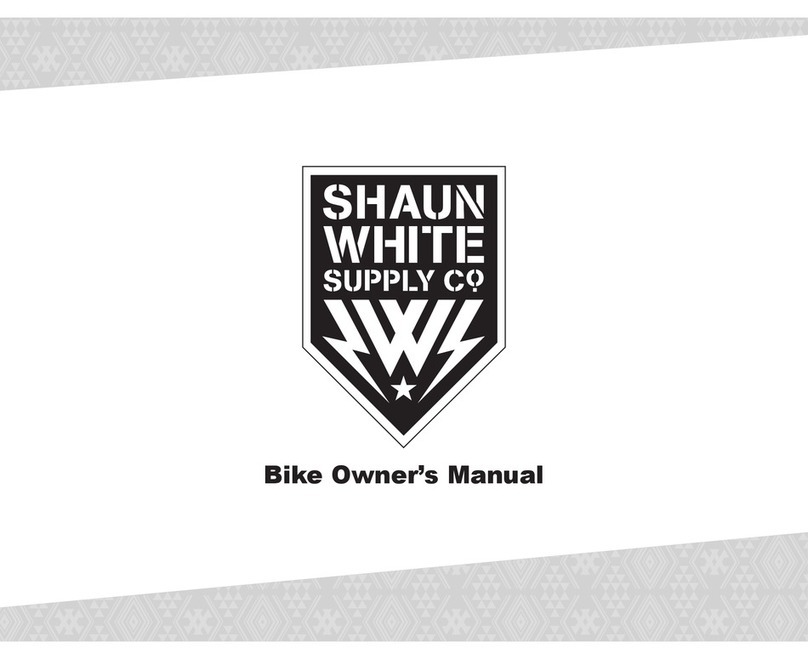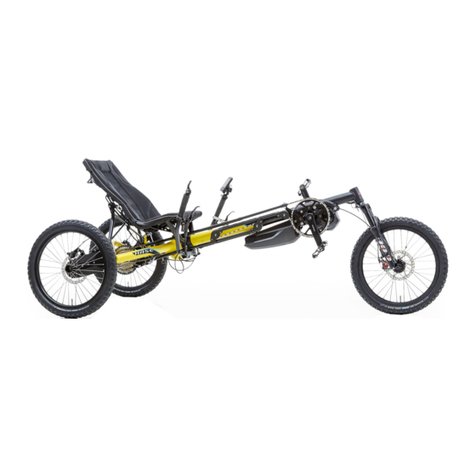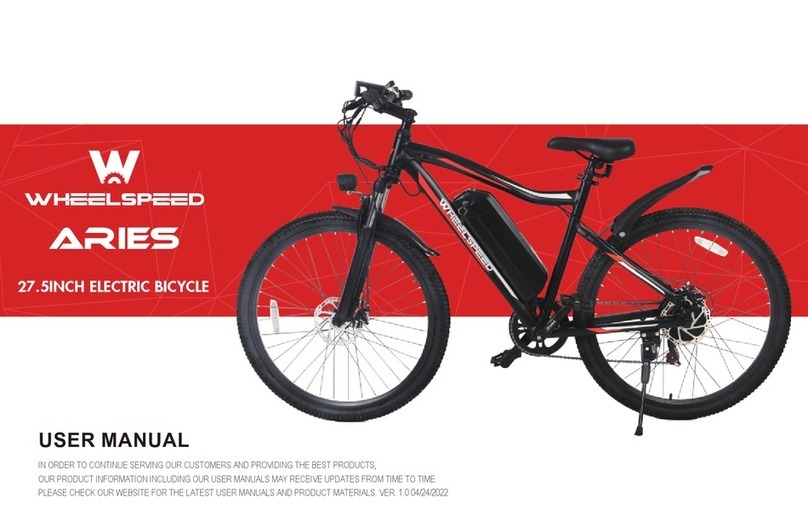DESTRO STEALTH ELITE BMX User manual


CONTENTS
A.
A.
p.
p.
Bicycle User Guide Page 1
Introduction Page 2
Size Chart Page 3
Components Page 4
Assembly Page 5 - 8
Handlebar & Stem Page 5
Saddle, Seat-post & Front Rim Page 6
Pedals, Chain, & Brake Page 7
Peg/s Page 8
Release of Liability Page 8
Safety First Page 9-16
Safety First Checklist Page 9
Mechanical Safety Check Page 10-11
The Basics Page 12-14
Wet Weather Riding Page 14
Night Riding Page 14-15
Safety Tips Page 16
Changing Components or Adding Accessories Page 16
First Ride Page 17
Service Intervals Page 17-19
The Lifespan of your Bike & it's Components Page 19
WARRANTY Page 20

BICYCLE USERS GUIDE
IMPORTANT: This manual contains important safety, performance, and
service information. Please read it before taking the first ride on your new
bicycle, and keep it for reference.
Additional safety, performance, and service information for specific
components such as suspension or pedals on your bicycle or
accessories such as helmets or lights that you purchase may also be
available. Make sure that your dealer has given you all the
manufacturers' literature with your bicycle and accessories.
If you have any questions or do not understand something, take
responsibility for your safety and consult with your dealer or the bicycle's
manufacturer (ISD Distribution).
NOTE: This manual is not intended as a comprehensive use, service, repair, or
maintenance manual. Please see your dealer for all service, repairs, or maintenance.
Your dealer may also be able to refer you to classes, clinics, or books on bicycle use,
service, repair, or maintenance.
GENERAL WARNING: Like any sport, bicycling involves the risk of
injury and damage. By choosing to ride a bicycle, you assume the
responsibility for that risk, so you need to know - and practice - the rules
of safe and responsible riding and proper use and maintenance. Proper
use and maintenance of your bicycle reduce the risk of injury.
This guide contains many "Warnings" and "Cautions" concerning the
consequences of failure to maintain or inspect your bicycle and for failure
to follow safe cycling practices.
Many of the Warnings and Cautions say, "you may lose control and fall."
However, because any fall can result in severe injury or even death, we
do not always repeat the warning of possible injury or death. It is
impossible to anticipate every situation or condition which can occur
while riding. Therefore, this guide makes no representation about the
safe use of the bicycle under all conditions. There are risks associated
with the help of any bicycle that cannot be predicted or avoided and are
the rider's sole responsibility.
1

INTRODUCTION
The following pages will provide you with the information you need to properly
use, adjust, maintain and service your new bike so that you can get the most
out of every ride.
It is essential that you read this owner's manual thoroughly before riding your
bicycle. We know you're anxious, but trust us, it will only take a few minutes,
and then you can unleash the full potential of your bicycle.
Please pay special attention to the safety information and cautions located
throughout this owner's manual, as they are in place to help you avoid serious
injury. If you encounter any issues with your bicycle that isn't covered in this
guide, please contact your nearest Authorized Dealer. As your number one
resource, your Elite BMX Co. Dealer can answer questions, perform required
maintenance, recommend the best equipment and gear to compliment your
ride, and provide a completely customized bike fit.
SPECIAL NOTE FOR PARENTS: Please, make sure the bicycle is
appropriately fitted to the child and keep the bike in operating condition
(maintenance). Teach and help the child understand the operation of the
bicycle and go over the bicycle and traffic laws. Therefore, as a parent, you
should read this manual, as well as review its warnings and the bicycle's
functions and operating procedures with your child before letting your child
ride the bicycle. As a parent or guardian, you are responsible for the activities
and safety of your child.
WARNING: Make sure that your child always wears an approved bicycle
helmet when riding, but also make sure that your child understands that a
bicycle helmet is for bicycling only and must be removed when not riding. A
helmet must not be worn while playing, in play areas, on playground
equipment, while climbing trees, or at any time while not riding a bicycle.
Failure to follow this warning could result in severe injury or death.
2

SIZE CHART
THE LENGTH OF THE TOP TUBE IS WHAT ALL BMX BIKES ARE
MEASURED BY. USE THIS HANDY CHART BELOW TO ENSURE
YOU GET THE CORRECT SIZE.
16” BIKE SIZE: Suitable Height -3ft to 3ft 6"
18” BIKE SIZE: Suitable Height -3ft 4" to 4ft 4"
20” BIKE SIZE: Suitable Height - 4ft to 5ft 6”
26" BIKE SIZE: Suitable Height - 4ft 2" to 5ft 10"
FOR THE BEST FIT CONTACT YOUR LOCAL BIKE SHOP OR AUTHORIZED
DEALER.
3

COMPONENTS
PART ASSEMBLY LIST
13. Brakes
14. Handlebar
15. Grips
16. Stem
17. Seat Post
18. Saddle
19. Pedals
1. Frame
2. Fork
3. Headset
4. Crankset
5. BB Set
6. Front Hub
7. Rear Hub
8. Cog/Freewheel
9. Chain
10. Spokes
11. Rim
12. Tires
4

ASSEMBLY
INTRODUCTION: This guide has been written to guide you through the additional
steps necessary to complete the assembly of your bike. These instructions are to
be used as a guide only.
The following instructions will guide you through:
Tools Required
Unpacking the bike
Assembling the handlebar
Inserting the handlebar assembly
Installing the saddle and seat post
Installing the front wheels
Installing and adjusting the brakes
Installing the pedals
If you are not confident in assembling this unit, refer to your authorized dealer
or professional bicycle mechanic.
TOOLS NEEDED: These standard tools can be found in your household. However, if
you do not have the proper tools, stop and head to your local bike shop.
UNPACKING THE BIKE: Remove all the packaging from your bike. Cut the Zip Ties
with scissors or wire cutters to prevent scratching of the frame and components.
Inspect the bike and all the included parts to make sure there are no damaged or
missing parts.
HANDLEBAR AND STEM: Using an Allen Wrench, remove the screws on the front
of the stem and take the stem face cover off. Place your handlebar centered into the
stem and install the stem cover and the bolts back on. Position the handlebar so they
are comfortable for the rider. Tighten the screws securely and evenly.
Air Pump (Schrader Valve)
Socket Wrench w/Extension 15 & 17mm
Cable Cutters or Scissors
Open-end or Adjustable Wrench
10mm & 15mm
Pedal Wrench 15mm
5mm & 6mm Allen Wrenches
5

To test the tightness of the stem Handlebar: Straddle the front wheel between
your legs. Try to turn the front wheel by turning the handlebar. If the handlebar and
stem turn without turning the front wheel, realign the stem with the front wheel and
tighten the stem bolts by the fork steering tighter than before. Do this step again
until the stem and bars do not turn without turning the front wheel. Hold the bicycle
stationary and try to move the ends of the handlebar up and down, forward and
back. If the handlebar moves, loosen the bolts from the handlebar clamp. Put the
handlebar in the correct position and tighten the bolts of the handlebar clamp tighter
than before. Since the handlebar clamp has more than one bolt, you need to tighten
the bolts equally. Do this test again until the handlebar does not move. Do not
exceed 100lbs of force when testing the handlebars.
SADDLE AND POST-INSTALLATION: Loosen the seat post clamp. If your bike
has a quick-release lever, rotate the quick-release clamp until it is fully open. If your
bike has a nutted seat post clamp, use a wrench (or Allen key if appropriate) to
loosen the clamp. Place the seat post into the frame and slide it down to the desired
height, ensuring the minimum insertion mark cannot be seen. Ensure the saddle is
aligned with the frame and set at the correct angle for comfortable cycling. Our
bicycles come with the pre-assembled seat to seat post so make sure it is aligned
to your desire. To align the saddle, stand over the bike and align the saddle's nose
to run parallel with the top tube of the frame.
Testing the Seat Clamp: If the seat post moves in the seat tube, loosen the clamp
screw. Then, put the seat in the correct position and tighten the screw tighter than
before. Do this test again till the seat post does not move.
WARNING: If your seat post is not inserted in the seat tube so that the
Minimum Insertion Mark cannot be seen, the seat post may break, which
could cause you to lose control.
6
ASSEMBLE THE FRONT WHEEL: Suppose you do not have a proper bicycle
stand. Turn the bike over so that it sits on the saddle and handlebars. Remove the
small plastic rod from between the fork ends. Your bicycle will come with either a
nutted front wheel or a front wheel with a quick-release mechanism. Place the front
wheel in the front fork dropout slots and ensure the wheel fits correctly. Ensure that
the fork dropout sits in between the lock washer and the cone nut. If your bicycle
has tabbed lock washers, ensure that the locking tabs are correctly mounted into
the holes in the forks. Then fully tighten both nuts and secure the wheel sits straight
in the forks. Ensure the wheel spins freely without contacting the fork.
WARNING: Failure to obey these steps can allow the front wheel to loosen
while riding. This can cause injury to the rider and others.

PEDALS INSTALLATION:The pedals are marked as either Right or Left, R or L.
The pedals will be marked on the end of the pedal spindle and possibly also by a
decal on the pedal body. The right-hand side of the bike is the chain-wheel side of
the bike. Insert the Right Pedal into the Right pedal arm and turn the thread
clockwise. Tighten with a 15mm wrench. Insert the Left Pedal into the Left pedal
arm, turn the thread counterclockwise, and tighten with a 15mm wrench. Although a
pedal wrench is preferred when installing pedals, an open-end wrench can also be
used. Ensure pedals are secure in crank arms so they will not loosen and
periodically check tightness.
WARNING: Incorrect attachment of the pedal into the crank arm can strip the
thread from the pedal spindle or the threads in the crank arm and cause
irreparable damage.
CHAIN ADJUSTMENTS: The chain must be at the correct tightness. If too tight,
the bicycle will be difficult to pedal. If too loose, the chain can come off the
sprockets. When the chain is at the correct tightness, you can rotate the crank
freely and pull it no more than half an inch away from a straightedge, as shown. To
adjust the chain, loosen the axle nuts, so they are hand tight. Next, turn the adjuster
chain tensioner with the Allen wrench so that the chain is the correct tightness.
Finally, hold the wheel in position and tighten both axle nuts to 21 ft-lbs when the
chain is tightened correctly.
WARNING: Do not attempt chain repairs. If there is a problem with the chain,
have your authorized dealer make the repairs.
Brake System Setup: You must adjust the front brakes before you ride the bicycle.
Start by aligning the brake pads in the correct position by loosening each screw on
the brake pad with your Allen wrench. Adjust each brake pad, so it's flat against the
rim and aligned with the curb of the rim. Make sure it does not rub on the tire. Hold
each brake pad in position and tighten the screw. Loosen the cable nut to lose, then
squeeze the brake arms so the pads come in contact with the rim. Pull the brake
cable tight, tighten the cable nut, and adjust it, so the pads have clearance with the
wheel. Ensure the brake lever is not loose and fully inserted into the adjustment
housing at the caliper and hand lever..
7

INSTALLING THE PEGS: Not all models carry both sets of Pegs; some
may ONLY have the rear set.
* 3/8" Front Rim Axle size - use a 15mm socket to remove Axle Nut.
* 14mm Rear Rim Axle size - use a 17mm socket to remove Axle Nut.
1. Start by removing the rear axle nut (14mm). Then, thread the nut
counterclockwise until it is entirely off the axle. Also, remove any washers
that were between the axle nut and the frame or fork.
2. Slide the peg over the end of the axle. Put your axle nut at the end of the
deep well socket and insert it at the end of the peg. Thread the axle nut
clockwise onto the axle but do not tighten completely.
If your bicycle came with front pegs, repeat the process, but use the 15mm
socket.
Thank you for buying an Elite BMX!
We're proud to be your brand of choice.
RELEASE OF LIABILITY: Bicycle riding is a hazardous sport and activity.
Therefore, this bicycle bought from IS Distribution or any of its authorized bicycle
dealers or distributors is understood to be the consumer's sole responsibility and
legal liability.
The consumer and purchaser of this branded bicycle or product understand and
acknowledge that bicycle riding may cause injury or death due to regular use,
abuse, poorly maintained equipment, stunt riding, road terrain, or accidents. I
hereby release IS Distribution, its owners, affiliates, and employees from all legal
liability from injury, property damage, and death to myself or my minor children
resulting from the assembly, maintenance, or use (as stated above of any such
equipment. I agree to defend, indemnify and hold harmless IS Distribution for and
from any injury to another person (s or property which I may cause as a result of
engaging in the activity of riding a bicycle from this distributor.
8

SAFETY FIRST
When riding your bike, always wear an approved helmet, and follow the helmet
manufacturer's instructions for fit, use, and care.
NOTE: We strongly urge you to read this guide in its entirety before your first ride. At
the very least, read and make sure that you understand each point in this section, and
refer to the cited sections on any issue which you don't completely understand. Please
note that not all bicycles have all of the features
SAFETY FIRST CHECKLIST
Is your bike the right size? To check, see the sizing chart. If your bicycle is too large or
too small for you, you may lose control and fall. If your new bike is not the right size,
ask your dealer to exchange it before you ride it.
Is the saddle at the right height? If you adjust your saddle height, follow the Minimum
Insertion instructions. Are saddle and seat posts securely clamped? A correctly
tightened saddle will allow no saddle movement in any direction.
Can you comfortably operate the brakes? If not, you may be able to adjust their angle
and reach.
Do you fully understand how to operate your new bicycle? If not, before your first ride,
have your dealer explain any functions or features which you do not understand
Familiarize yourself with the laws of the areas where you ride and comply with all
applicable laws.
Do you know how to secure your front and rear wheels correctly? Riding with an
improperly secured wheel can cause the wheel to wobble or disengage from the
bicycle and cause severe injury or death.
If your bike has toe clips and straps or clip-less ("step-in") pedals, make sure you know
how they work. These pedals require special techniques and skills. Follow the pedal
manufacturer's instructions for use, adjustment, and care.
9

MECHANICAL SAFETY CHECK: Routinely check the condition of your bicycle
before every ride.
Nuts, bolts & other fasteners: Because manufacturers use a wide variety of
fastener sizes and shapes made in various materials, often differing by model and
component, the correct tightening force or torque cannot be generalized. To make
sure that the many fasteners on your bicycle are correctly tightened, refer to the
Fastener Torque Specifications. Correctly tightening a fastener requires a
calibrated torque wrench. A professional bicycle mechanic with a torque wrench
should torque the fasteners on your bicycle. If you choose to work on your bicycle,
you must use a torque wrench and the correct tightening torque specifications from
the bicycle or component manufacturer or your dealer. If you need to make an
adjustment at home or in the field, we urge you to exercise care and to have the
fasteners you worked on checked by your dealer as soon as possible.
Make sure nothing is loose. Lift the front wheel off the ground by two or three
inches, then let it bounce on the floor, and if you hear any sound, there might be
some loose parts. Do a visual and tactile inspection of the whole bike. Any loose
parts or accessories secure them.
WARNING: Correct tightening force on fasteners -nuts, bolts, screws on your
bicycle is important. Too little pressure and the fastener may not hold securely. Too
much power and the fastener can strip threads, stretch, deform or break. Either
way, incorrect tightening force can result in component failure, which can cause
you to lose control and fall.
Tires & Wheels: Make sure tires are correctly inflated. Check by putting one hand
on the saddle, one on the intersection of the handlebars and stem, then bouncing
your weight on the bike while looking at tire deflection. Compare what you see with
how it looks when you know the tires are correctly inflated and adjust if necessary.
Are wheels true? Spin each wheel and check for brake clearance and side-to-side
wobble. If a wheel wobbles side to side even slightly or rubs against or hits the
brake pads, take the bike to a qualified bike shop to have the wheel trued.
CAUTION: Wheels must be true for rim brakes to work effectively. Wheel truing is a
skill that requires special tools and experience. Do not attempt to true a wheel
unless you have the knowledge, experience, and tools to do the job correctly.
Are wheels clean and undamaged? Make sure the rims are clean and undamaged
at the tire bead.
10

WARNING: Bicycle wheel rims are subject to wear. Ask your dealer about wheel
rim wear. Some wheel rims have a rim wear indicator which becomes visible as
the rim's braking surface wears. Visible wear on the side of the wheel rim is an
indication that the wheel rim has reached its maximum usable life. Riding a wheel
that is at the end of its functional life can result in wheel failure, which can cause
you to lose control and fall.
Brakes: Check the brakes for proper operation. Squeeze the brake levers….
Are the brake quick-releases closed?
All control cables seated and securely engaged?
Do the brake pads contact the wheel rim squarely and make complete
contact with the rim?
Do the brakes begin to engage within an inch of brake lever movement?
Can you apply full braking force at the levers without having them touch the
handlebar? If not, your brakes need to be adjusted by a professional bicycle
mechanic.
Wheel retention system: Make sure the front and rear wheels are correctly
secured.
Handlebar and saddle alignment: Make sure the saddle and handlebar stem is
parallel to the bike's centerline and clamped tight enough so that you can't twist
them out of alignment.
Handlebar ends: Make sure the handlebar grips are secure and in good
condition. If not, have your dealer replace them. Make sure the handlebar ends
and extensions are plugged. If not, have your dealer plug them before you ride. If
the handlebars have bar-end extensions, make sure they are clamped tight
enough so you can't twist them.
WARNING: Loose or damaged handlebar grips or extensions can cause you to
lose control and fall. Unplugged handlebars or extensions can cut you and cause
serious injury in an otherwise minor accident.
VERY IMPORTANT SAFETY NOTE: Please also read and become thoroughly
familiar with the vital information on the lifespan of your bicycle and its
components.
11

THE BASICS
WARNING: The area in which you ride may require specific safety devices. It
is your responsibility to familiarize yourself with the laws of the place you ride
and complies with all applicable laws, including adequately equipping yourself
and your bike as the law requires. Observe all local bicycle laws and
regulations. Observe regulations about bicycle lighting, licensing of bicycles,
riding on sidewalks, laws regulating bike path and trail use, helmet laws, child
carrier laws, special bicycle traffic laws. Again, it's your responsibility to know
and obey the laws.
Always wear a cycling helmet that meets the latest certification standards and
is appropriate for the riding you do. Always follow the helmet manufacturer's
instructions for fit, use, and care of your helmet. Most serious bicycle injuries
involve head injuries which might have been avoided if the rider had worn an
appropriate helmet.
12
WARNING: Failure to wear a helmet when riding may result in severe injury or
death.
Always do the Mechanical Safety Check before you get on a bike.
Be thoroughly familiar with the controls of your bicycle.
Be careful to keep body parts and other objects away from the sharp teeth of
chain-rings, the moving chain, the turning pedals and cranks, and the spinning
wheels of your bicycle.
Always wear shoes that will stay on your feet and will grip the pedals. Make
sure that shoelaces cannot get into moving parts and never ride barefoot.
Bright, visible clothing that is not so loose can be tangled in the bicycle or
snagged by objects at the side of the road or trail. Protective eye-wear protects
against airborne dirt, dust, and bugs - tinted when the sun is bright, evident
Don't jump with your bike. Jumping a bike, particularly a BMX or mountain bike,
can be fun; but it can put huge and unpredictable stress on the bicycle and its
components. Riders who insist on jumping their bikes risk severe damage to their
bicycles as well as to themselves. Read and understand the guidelines before
you attempt to jump, do stunt riding, or race with your bike.

Ride at a speed appropriate for conditions. Higher speed means higher risk.
Obey all Rules of the Road and all local traffic laws.
You are sharing the road or the path with others - motorists, pedestrians, and
other cyclists. Respect their rights.
Ride defensively. Always assume that others do not see you.
Look ahead, and be ready to avoid: Vehicles slowing or turning, entering the
road or your lane ahead of you, or coming up behind you—parked car doors
opening. Pedestrians are stepping out. Children or pets are playing near the
road. Potholes, sewer, railroad tracks, expansion joints, road or sidewalk
construction, debris, and other obstructions could cause you to swerve into
traffic, catch your wheel or cause you to have an accident—the many different
hazards and distractions which can occur on a bicycle ride.
13
Ride in designated bike lanes, on designated bike paths, or as close to the edge of
the road as possible, in the direction of traffic flow or as directed by local governing
laws.
Stop at stop signs and traffic lights; slow down and look both ways at street
intersections. Remember that a bicycle always loses in a collision with a motor
vehicle, so be prepared to yield even if you have the right of way. use approved hand
signals for turning and stopping.
Unless it is a small child wearing an approved helmet and secured in a correctly
mounted child carrier or a child-carrying trailer, never carry a passenger.
Never carry anything which obstructs your vision or your complete control of the
bicycle, or which could become entangled in the moving parts of the bicycle.
Never hitch a ride by holding on to another vehicle.
Don't do stunts, wheelies, or jumps. If you intend to do tricks, wheelies jump, or go
racing with your bike despite our advice not to. Know it will void the warranty. Think
carefully about your skills before deciding to take the significant risks that go with this
kind of riding
Don't weave through traffic or make any moves that may surprise people you are
sharing the road with.

Don't weave through traffic or make any moves that may surprise people you are
sharing the road with.
Observe and yield the right of way.
Never ride your bicycle while under the influence of alcohol or drugs.
If possible, avoid riding in bad weather, when visibility is obscured, at dawn, dusk, in
the dark, or when extremely tired. Each of these conditions increases the risk of an
accident.
WET WEATHER RIDING
WARNING: Wet weather impairs traction, braking, and visibility, both
for the bicyclist and other vehicles are sharing the road. The risk of an accident is
dramatically increased in wet conditions. Under wet conditions, the stopping power of
your brakes (as well as the brakes of other vehicles sharing the road) is dramatically
reduced, and your tires don't grip nearly as well. This makes it harder to control speed
and easier to lose control. To ensure that you can slow down and stop safely in wet
conditions, ride more slowly and apply your brakes earlier and more gradually than
you would under normal, dry conditions.
14
NIGHT RIDING
Riding a bicycle at night is much more dangerous than riding during the day. In
addition, a bicyclist is very difficult for motorists and pedestrians to see. Therefore,
children should never ride at dawn or night. Adults who chose to accept the
significantly increased risk of riding at dawn should take extra care in both riding
and selecting the right light equipment, which helps reduce that risk.
WARNING: Reflectors are not a substitute for required lights. Riding at dawn, at
dusk, at night, or at other times of poor visibility without an adequate bicycle
lighting system and without reflectors is dangerous and may result in severe injury
or death.
Bicycle reflectors are designed to pick up and reflect car lights and street lights in
a way that may help you to be seen and recognized as a moving bicyclist.
CAUTION: Check reflectors and their mounting brackets regularly to ensure clean,
straight, unbroken, and securely mounted. Have your dealer replace damaged
reflectors.

The mounting brackets of front and rear reflectors are often designed as brake
straddle cable safety catches which prevent the straddle cable from catching on
the tire tread.
WARNING: Do not remove the front or rear reflectors or reflector brackets from
your bicycle. They are an integral part of the bicycle's safety system. Removing
the reflectors reduces your visibility to others using the roadway. Being struck by
other vehicles may result in severe injury or death. In addition, the reflector
brackets may protect you from a brake straddle cable catching on the tire in the
event of brake cable failure. If a brake straddle cable catches on the tire, it can
cause the wheel to stop suddenly, causing you to lose control and fall.
If you choose to ride under conditions of poor visibility, check and be sure
you comply with all local laws about night riding and take the following
strongly recommended additional precautions:
Wear light-colored, reflective clothing and accessories, such as a reflective vest,
reflective arm and leg bands, reflective stripes on your helmet, flashing lights
attached to your body or your bicycle ... any reflective device or light source that
will help you get the attention of approaching motorists, pedestrians, and other
traffic.
15
While riding at dawn, at dusk, or night:
Ride slowly.
Avoid dark areas and areas of heavy or fast-moving traffic.
Avoid road hazards.
If possible, ride on familiar routes.
If riding in traffic:
Be predictable. Ride so that drivers can see you and predict your movements.
Be alert. Ride defensively and expect the unexpected.
If you plan to ride in traffic often, ask your dealer about traffic safety classes or a
good book on bicycle traffic safety.

Safety Tips:
Check with your dealer or the bicycle's manufacturer about the suitability of your
bicycle before engaging in extreme riding. When riding downhill, you can reach
speeds achieved by motorcycles and face similar hazards and risks. Have your
bicycle and equipment carefully inspected by a qualified mechanic, and be sure it is in
perfect condition. Consult with expert riders, area site personnel, and race officials on
requirements and equipment advisable at the site where you plan to ride. Wear
appropriate safety gear, including an approved full-face helmet, full finger gloves, and
body armor. Ultimately, it is your responsibility to have the proper equipment and to
be familiar with course conditions.
WARNING: Although many catalogs, advertisements, and articles about bicycling
depict riders engaged in extreme riding, this activity is hazardous. It increases your
risk of injury or death and increases the severity of an injury. Remember that the
action depicted is being performed by professionals with many years of training and
experience. Know your limits and always wear a helmet and other appropriate safety
gear. Even with state-of-the-art protective safety gear, you could be seriously injured
or killed when jumping, stunt riding, riding downhill at speed, or in competition. In
addition, bicycles and bicycle parts have limitations concerning strength and integrity,
and this type of riding can exceed those limitations.
We recommend against this type of riding because of the increased risks, but if you
choose to take the risk, take lessons from a competent instructor first. Start with easy
learning exercises and slowly develop your skills before trying more difficult or
dangerous riding. Use only designated areas for stunts, jumping, racing, or fast
downhill riding. Wear a full-face helmet, safety pads, and other safety gear.
Understand and recognize that the stresses imposed on your bike by this kind of
activity may break or damage parts of the bicycle and void the warranty.
16
CHANGING COMPONENTS OR ADDING ACCESSORIES
There are many components and accessories available to enhance your bicycle's
comfort, performance, and appearance. However, if you change components or add
accessories, you do so at your own risk. The bicycle's manufacturer may not have
tested that component or accessory for compatibility, reliability, or safety on your
bicycle. Before installing any component or accessory, including a different size tire,
ensure that it is compatible with your bicycle by checking with your dealer. Be sure
to read, understand and follow the instructions that accompany the products you
purchase for your bicycle.

17
FIRST RIDE
When you buckle on your helmet and go for your first familiarization ride on your
new bicycle, be sure to pick a controlled environment, away from cars, other
cyclists, obstacles, or other hazards. Then, ride to become familiar with the controls,
features, and performance of your new bike.
Familiarize yourself with the braking action of the bike. Test the brakes at slow
speed, putting your weight toward the rear and gently applying the brakes, rear
brake first. Sudden or excessive application of the front brake could pitch you over
the handlebars. On the other hand, using brakes too hard can lock up a wheel,
which could cause you to lose control and fall. Skidding is an example of what can
happen when a wheel locks up.
If your bicycle has toe-clips or clip-less pedals, practice getting in and out of the
pedals.
If your bicycle has shifters, practice shifting the gears. Remember never to move
the shifter while pedaling backward, nor pedal backward immediately after having
moved the shifter. This could jam the chain and cause severe damage to the
bicycle. Instead, check out the handling and response of the bike and check the
comfort. If you have any questions or feel that the bike is not as it should be, consult
your dealer before you ride again.
SERVICE INTERVALS
Some service and maintenance can and should be performed by the owner and
require no special tools or knowledge beyond what is presented in this guide. The
following are examples of the type of service you should perform yourself. All other
services, maintenance, and repair should be performed in a properly equipped
facility by a qualified bicycle mechanic using the correct tools and procedures
specified by the manufacturer.
Break-in Period: Your bike will last longer and work better if you break it in before
riding it hard. Control cables and wheel spokes may stretch or "seat" when a new
bike is first used and may require readjustment by your dealer. Your Mechanical
Safety Check will help you identify some things that need readjustment. But even if
everything seems fine to you, it's best to take your bike back to the dealer for a
checkup. Dealers typically suggest you bring the bike in for a 30-day checkup.
Another way to judge when it's time for the first checkup is to get the bike in after
three to five hours of hard off-road use, or about 1 0 to 15 hours of on-road or more
casual off-road use. But if you think something is wrong with the bike, take it to your
dealer before riding it again.

mechanic.
Repeat the above process for the rear wheel.
CHECK YOUR CRANK ARMS AND PEDALS:With the bike resting on the
ground, stand on the right side of it. The crank is the arm that the pedal is
connected to; rotate the cranks so that the arm is pointed up. Grasp the crank arm
with one hand, and tug on it firmly, pulling it towards you and then towards the bike.
You should not feel any play or movement.
Repeat on the left side of the bike.
If you feel play in the crank arms on both sides, likely, the bottom bracket (the set of
ball bearings that allow the crank arms to turn) needs to be serviced or replaced.
On the other hand, if you feel play on only one side, the crank arm itself is probably
loose. You may be able to tighten it back down using the bolt in the center, but if it
has worked itself loose, it probably needs to be replaced.
CHECK STEM AND HEADSET:The stem is the component that holds the
handlebar in place. Stand over the bike with the front wheel between your legs.
Grasp the handlebar firmly and try to turn the handlebar without turning the wheel. If
the handlebar turns, DO NOT ride the bike and have it checked by a qualified
bicycle mechanic.
The headset is the group of ball bearings inside the front part of the bike (the head
tube) that enable the steering to operate. To check that they are correctly adjusted,
grab the left-hand (front) brake lever and rock the bike forward and backward while
you hold onto the outside of the bearing areas (at the top and bottom of the frame's
head tube). If you feel any play in the bearings, they need to be adjusted by a
qualified bicycle mechanic.
If the bike is exposed to water or grit, or at least every 100 miles: Clean the bike
and lightly lubricate the chain's rollers with a good quality bicycle chain lubricant.
Wipe off excess lubricant with a lint-free cloth. Lubrication is a function of climate.
Talk to your dealer about the best lubricants and the recommended lubrication
frequency for your area. Avoid contaminating the rims with lubricant!
After 10 to 20 hours of riding
CHECK YOUR BRAKES: Grasp the left-hand (front) brake lever firmly, and rock
the bike forward and backward. The brakes should hold firmly without slipping or
squealing.
Repeat using the right-hand (rear) brake lever. If either brake does not hold firmly,
do not ride the bike and have the brakes checked by a qualified bicycle mechanic.
Check your tire pressure
Press down on each tire. They should feel stiff and not soft. If they are a bit soft,
you can be sure they need some air. Check the recommended pressure listed on
the sidewall of the tire.
Check your wheels: With the bike resting on the ground, hold the handlebars with
one hand, and grab the top of the front wheel with the other hand. Try to rock the
wheel side-to-side; there should NOT be any "play" or movement in this direction.
Lift the front end of the bike and spin the front wheel. As the wheel spins, it should
feel and sound smooth. If it makes a crunchy or grinding noise, or if the wheel
wobbles from side to side as it spins, have it serviced by a qualified bicycle
CHECK YOUR CHAIN: Closely inspect the chain. If there's a little surface rust, then
you can probably get away with cleaning and re-lubricating it. However, if it's
completely covered solid with rust, then it needs to be replaced.
Spin the cranks backward and observe if the chain moves freely over the cogs
without kinking, skipping, or binding. It should turn relatively quietly without squealing
or grinding. If it does any of these, it needs to be cleaned and lubricated.
If the chain is covered with grease grime, either partially or entirely, then clean and
lubricate it.
IF YOUR BICYCLE SUSTAINS AN IMPACT
First, check yourself for injuries, and take care of them as best you can. Seek
medical help if necessary. Next, check your bike for damages. Finally, please do
NOT ride the bicycle until a qualified mechanic has thoroughly inspected the bicycle.
18
Table of contents
Popular Bicycle manuals by other brands
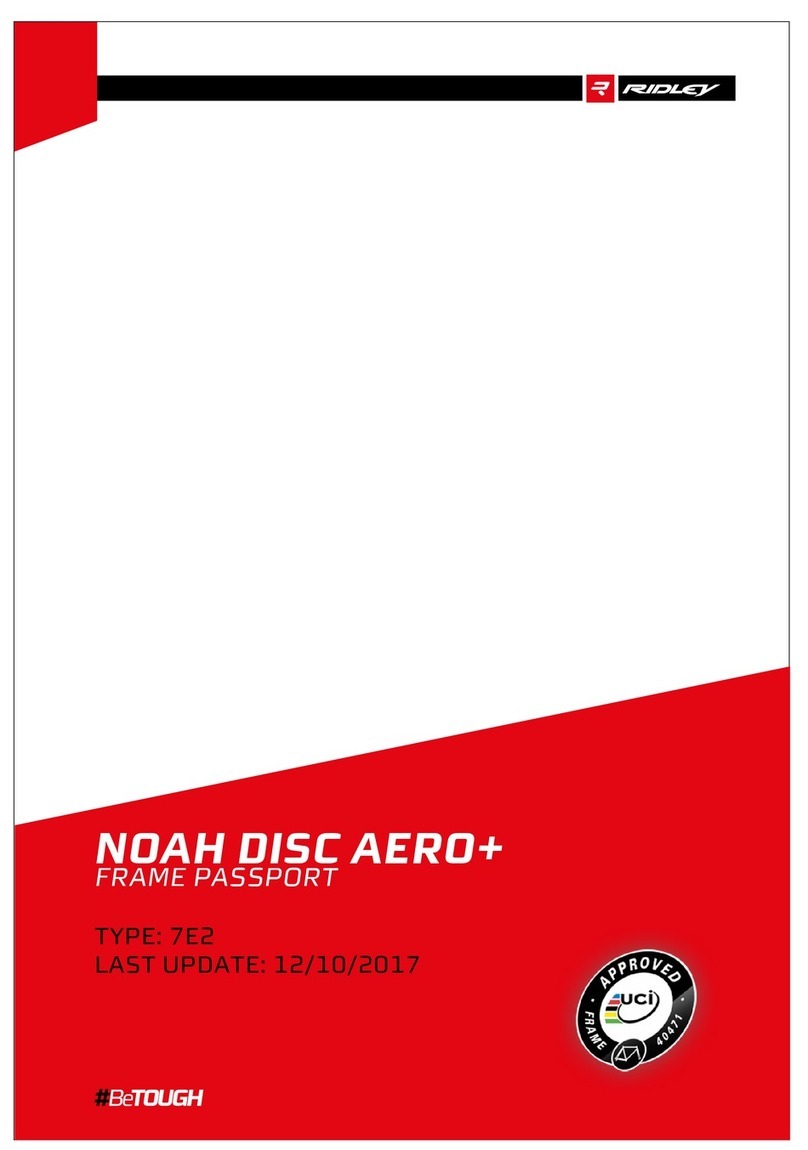
RIDLEY
RIDLEY NOAH DISC AERO+ Passport
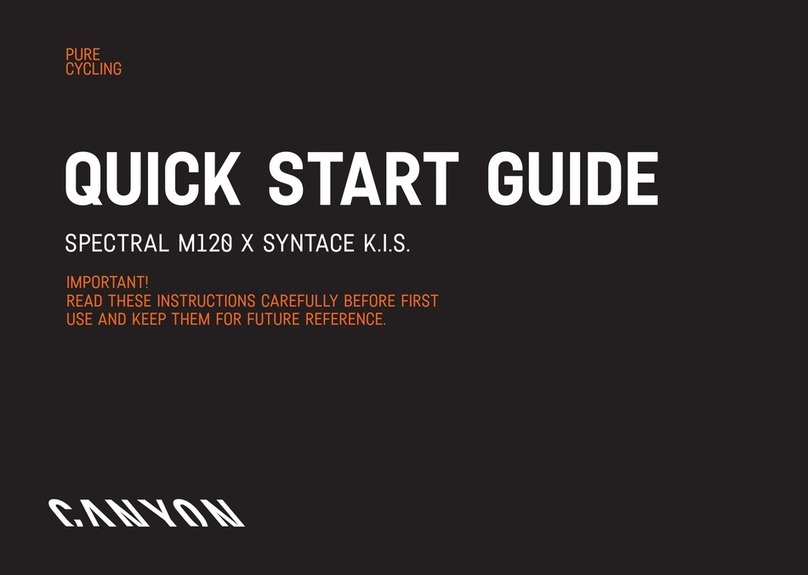
Canyon
Canyon SPECTRAL M120 X SYNTACE K.I.S. quick start guide
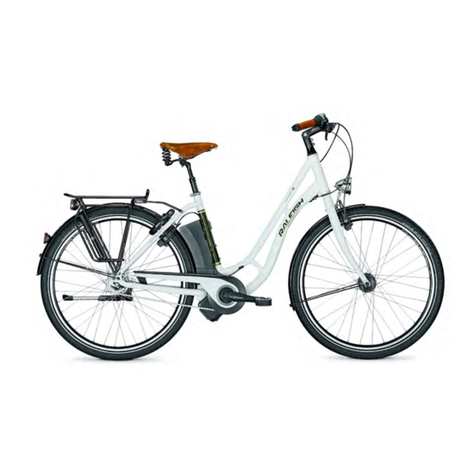
Raleigh
Raleigh Pedelec Groove* user manual
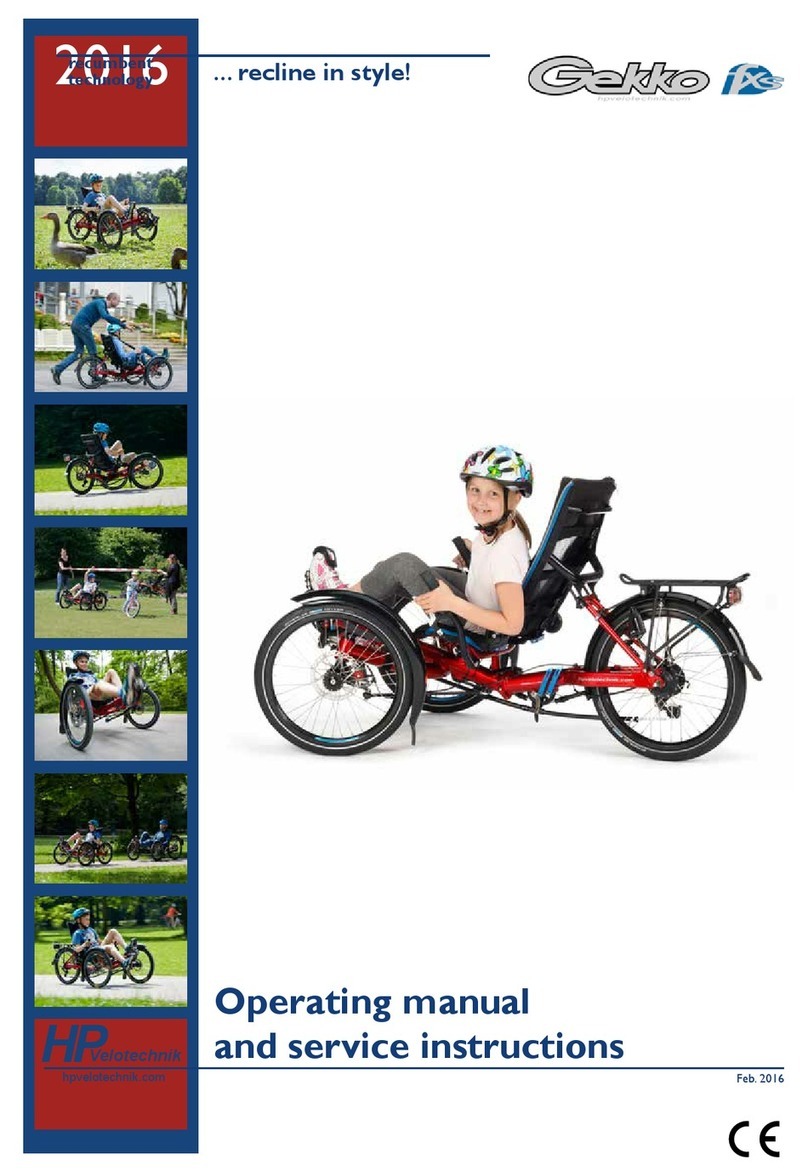
HP Velotechnik
HP Velotechnik Gekko fxs Operating manual and service instructions
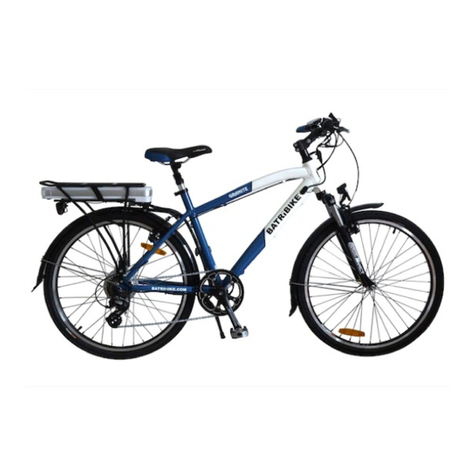
Batribike
Batribike Pro Spec Series owner's manual

EV4
EV4 City Quad Battery installing guide
